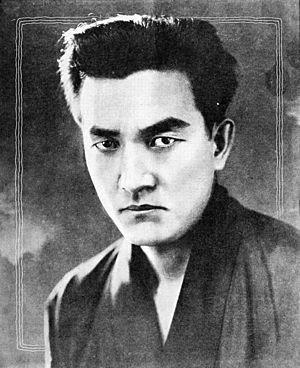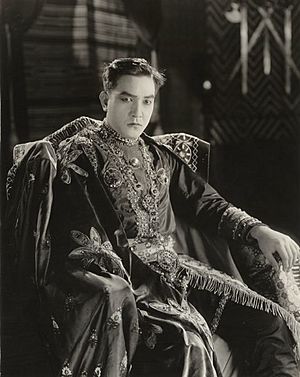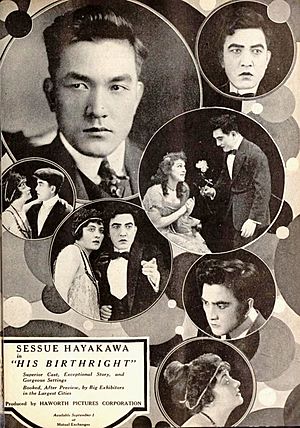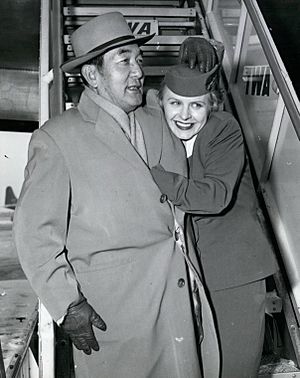Sessue Hayakawa facts for kids
Quick facts for kids
Sessue Hayakawa
|
|
|---|---|
| 早川 雪洲 | |
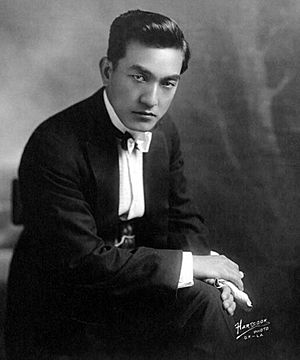
Hayakawa, 1918
|
|
| Born |
早川 金太郎 (Hayakawa Kintarō)
June 10, 1886 Minamibōsō, Chiba, Empire of Japan
|
| Died | November 23, 1973 (aged 87) Tokyo, Japan
|
| Occupation | Actor |
| Years active | 1914–1966 |
| Spouse(s) | |
| Children | 3 |
Kintarō Hayakawa (Japanese: 早川 金太郎, Hepburn: Hayakawa Kintarō, June 10, 1886 – November 23, 1973), known as Sessue Hayakawa (早川 雪洲, Hayakawa Sesshū), was a famous Japanese actor. He was a huge star in Hollywood during the silent film era (the 1910s and early 1920s). Hayakawa was the first actor of Asian background to become a leading man and a big star in the United States and Europe.
After leaving the Japanese naval academy, Hayakawa went to the University of Chicago. He studied political economics because his wealthy parents wanted him to be a banker. He then traveled to Los Angeles to go back to Japan. But he decided to try acting in Little Tokyo. There, Hayakawa impressed Hollywood producers and got a role in The Typhoon (1914). He became very famous with The Cheat (1915). After that, he was known for playing romantic roles.
Hayakawa was one of the highest-paid stars of his time. He earned $5,000 a week in 1915. From 1918 to 1921, his own movie company made $2 million a year. Because of growing anti-Japanese feelings and business problems, Hayakawa left Hollywood in 1922. He acted on Broadway and in Japan and Europe for many years. He returned to Hollywood in Daughter of the Dragon (1931).
For his movies with sound (called talkies), Hayakawa is best known for two roles. He played Kuala, the pirate captain in Swiss Family Robinson (1960). He also played Colonel Saito in The Bridge on the River Kwai (1957). For this role, he was nominated for an Academy Award for Best Supporting Actor. Hayakawa starred in over 80 feature films. Three of his films, The Cheat, The Dragon Painter, and The Bridge on the River Kwai, are kept in the United States National Film Registry.
Contents
Early Life and First Steps in Acting
Hayakawa was born Kintaro Hayakawa (早川 金太郎, Hayakawa Kintarō). He was born in a village called Nanaura, which is now part of Minamibōsō in Chiba Prefecture, Japan. His birthday was June 10, 1886. From a young age, he wanted to travel overseas and studied English. His father was a wealthy leader of a fishermen's union. Hayakawa had five brothers and sisters.
His family wanted him to become an officer in the Imperial Japanese Navy. But while he was a student at the naval academy, he hurt his ear during a swimming dare. This injury meant he could not pass the navy's physical test. His father was very disappointed, which caused problems between them.
Hayakawa then moved to the United States. He began studying political economics at the University of Chicago. This was to fulfill his family's new wish for him to become a banker. While at college, he reportedly played football and once used jujitsu to tackle an opponent. Hayakawa finished college in 1912 and planned to go back to Japan.
He traveled to Los Angeles to wait for a ship across the Pacific Ocean. During his stay, he found the Japanese Theatre in Little Tokyo. He became very interested in acting and performing plays. Some stories about his early life are debated. Some say he did not attend the University of Chicago. They say he worked many odd jobs in California before acting.
It was around this time that Hayakawa started using his stage name, Sessue (雪洲, Sesshū). This name means "snowy continent." He performed in a play called The Typhoon. Tsuru Aoki, another actor in the group, was very impressed with Hayakawa. She convinced film producer Thomas H. Ince to see the play. Ince liked the show and offered to make it into a silent film with the original actors.
Hayakawa wanted to return to Japan. He tried to get Ince to say no by asking for a very high fee of $500 a week. But Ince agreed to pay him. The Typhoon (1914) became a big hit right away. Ince then produced two more films: The Wrath of the Gods (1914), which starred Hayakawa's new wife, Aoki, and The Sacrifice (1914). As Hayakawa became more famous, Jesse L. Lasky offered him a contract. Hayakawa accepted and joined Famous Players–Lasky (now Paramount Pictures).
Becoming a Movie Star
Hayakawa's second film for Famous Players–Lasky was The Cheat (1915). It was directed by Cecil B. DeMille. The Cheat also starred Fannie Ward as Hayakawa's love interest. The movie was a huge success. It made Hayakawa a romantic hero for many female movie fans. He was very popular and considered handsome. At the peak of his fame in 1919, he earned over $3,500 a week. In 1917, he built a castle-like mansion in Hollywood. It was a famous local building until it was torn down in 1956.
After The Cheat, Hayakawa became a leading man in romantic dramas. This was during the 1910s and early 1920s. He also started acting in Westerns and action films. He wanted different roles but was often given the same type of character. Because of this, Hayakawa decided to start his own movie company. His company was called Haworth Pictures Corporation.
Over the next three years, Hayakawa made 23 films. By 1920, he had earned $2 million. He produced, starred in, and helped with the writing, editing, and directing of his films. Critics praised Hayakawa's calm, Zen-influenced acting style. He tried to bring a sense of "absence of doing" to his acting. This was different from the popular acting style of big poses and gestures at the time. In 1918, Hayakawa chose American actress Marin Sais to act with him. They made several films together, including The City of Dim Faces (1918) and His Birthright (1918). His wife, Aoki, also starred in His Birthright. Hayakawa also appeared with Jane Novak in The Temple of Dusk (1918) and Aoki in The Dragon Painter (1919).
Some sources say Hayakawa's fame was as big as that of Douglas Fairbanks, Charlie Chaplin, and John Barrymore. He drove a fancy gold-plated car and hosted grand parties at his "Castle."
Hayakawa left Hollywood in 1922. Many reasons are given, including growing anti-Japanese feelings and business problems. He visited Japan with Aoki for the first time since coming to the US. He soon returned and played the main role in a play called Tiger Lily on Broadway in 1923. For the next 15 years, he also performed in Japan and Europe. In London, Hayakawa starred in The Great Prince Shan (1924). In 1925, he wrote a novel called The Bandit Prince and turned it into a play. In 1930, Hayakawa performed a play called Samurai for King George V and Queen Mary of Great Britain. Hayakawa became very well-known in France. His first French film, La Bataille (1923), was a big success. German audiences found him "sensational." In Russia, he was seen as one of America's "wonderful actors." Hayakawa also made many Japanese films and a Japanese stage version of The Three Musketeers. In the early part of his career, Hayakawa became the first Asian leading man in American and European movies. He was also the first non-white actor to become an international star.
Later Career and Famous Roles
Hayakawa returned to the United States in 1926 to act on Broadway. He later opened a Zen temple and study hall in New York. Hayakawa then started acting in movies with sound, called talkies. His return to Hollywood and first sound film was Daughter of the Dragon (1931). He starred opposite Chinese American actress Anna May Wong. His accent was sometimes a challenge when sound was added to movies.
Hayakawa played a samurai in the German-Japanese movie The Daughter of the Samurai (1937). The same year, Hayakawa went to France to film Yoshiwara (1937). He became stuck in France and separated from his family when Germany occupied France in 1940. Hayakawa made few films during these years. He supported himself by selling his watercolor paintings. He became friends with writer Jirōhachi Satsuma, who was also stuck in France. Some sources say he joined the French Resistance and helped Allied pilots during World War II. However, Hayakawa himself said he mainly helped the local Japanese community during and after the war. He traveled a lot until 1950.
In 1949, Humphrey Bogart's movie company found Hayakawa. They offered him a role in Tokyo Joe. Before he could get a work permit, the American Consulate checked his activities during the war. They found he had not helped the German war effort at all. After Tokyo Joe, Hayakawa starred in Three Came Home (1950). In this film, he played a real-life POW camp commander, Lieutenant-Colonel Suga. He then returned to France.
After the war, Hayakawa often played "honorable villains" in his movies. A great example is his role as Colonel Saito in The Bridge on the River Kwai (1957). This film won the Academy Award for Best Picture. Hayakawa was nominated for Best Supporting Actor and a Golden Globe. He called this role the best of his career. After this film, Hayakawa mostly stopped acting. He made guest appearances on a few TV shows and films. His last performance was in the animated film The Daydreamer (1966).
After retiring, Hayakawa focused on Zen Buddhism. He became an ordained Zen master. He also worked as a private acting coach. He wrote his autobiography, Zen Showed Me the Way.
Breaking Barriers
Throughout Hayakawa's career, many people in American society had anti-Japanese feelings. This was partly due to nationalism from World War I and World War II. Hayakawa was often given the same types of roles. He was usually cast as a villain or a forbidden lover. He could not play roles that would be given to white actors like Douglas Fairbanks. Hayakawa once said, "Such roles... are not true to our Japanese nature... They are false and give people a wrong idea of us. I wish to make a characterization which shall reveal us as we really are." In 1949, he sadly said, "My one ambition is to play a hero."
Hayakawa's situation was similar to Rudolph Valentino's. Both were born in other countries and were often cast as exotic or forbidden lovers. Hayakawa refused to star in The Sheik to start his own company. This role then went to the less known Valentino, making him a huge star.
In 1930, the Production Code came into effect. This rule (enforced after 1934) did not allow movies to show relationships between people of different races. This meant that unless Hayakawa's co-star was an Asian actress, he could not play a romantic role with her. Hayakawa faced this problem because of his ethnicity. At that time, laws prevented him from becoming a U.S. citizen. Also, anti-miscegenation laws meant he could not marry someone of another race.
Hayakawa's early films were not popular in Japan. Many people felt that his roles showed Japanese men as cruel. Some Japanese viewers found this insulting. Nationalist groups were especially critical. Some Japanese believed Hayakawa was making anti-Japanese feelings worse in the U.S. They saw him as a traitor. But after Hayakawa became a big American star, the negative comments in the Japanese press lessened. Japanese media started to praise his movie achievements. His later films were also not popular in Japan. This was because he was seen as "too Americanized" during a time of strong nationalism.
Personal Life
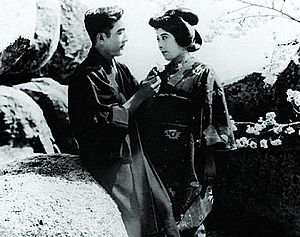
On May 1, 1914, Hayakawa married Tsuru Aoki. She was also a Issei performer and co-starred in several of his films. Hayakawa had been married before to a white actress named Ruth Noble. She was a vaudeville performer who acted with him in The Bandit Prince. Noble gave birth to a son, Alexander Hayes. They divorced in 1929, and Hayakawa got custody of their child. Sessue and Aoki adopted him, changing his name to Yukio. They raised and educated him in Japan. Later, they adopted two more daughters: Yoshiko, who became an actress, and Fujiko, a dancer. Aoki passed away in 1961.
Hayakawa was known for his athletic body and quickness. A 1917 description said he was skilled in jiu-jitsu and fencing. He could swim very well and was a good horseman. He also played tennis. He was tall for a Japanese man, at five feet seven and a half inches (171.45 cm) and weighed 157 pounds (71.21 kg). Hayakawa was known for his strong self-discipline and martial arts skills.
Later Years and Legacy
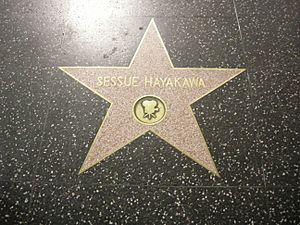
Hayakawa stopped making films in 1966. He died in Tokyo on November 23, 1973. The cause was a cerebral thrombosis (a type of stroke), made worse by pneumonia. He was buried in the Chokeiji Temple Cemetery in Toyama, Japan.
Many of Hayakawa's films are now lost. However, most of his later movies are available on DVD. These include The Bridge on the River Kwai, the Jerry Lewis comedy The Geisha Boy (where Hayakawa makes fun of his role in The Bridge on the River Kwai), Swiss Family Robinson (1960 film), Tokyo Joe, and Three Came Home. In 1960, Hayakawa received a star on the Hollywood Walk of Fame. It is located at 1645 Vine Street in Hollywood, Los Angeles, California. This honored his important work in the movie industry.
A musical about Hayakawa's life, called Sessue, was performed in Tokyo in 1989. In September 2007, the Museum of Modern Art showed a special collection of Hayakawa's work. It was called Sessue Hayakawa: East and West, When the Twain Met. Japanese film director Nagisa Oshima planned to make a movie about Hayakawa's life called Hollywood Zen. The script was supposedly finished, but the movie was never made due to delays and Oshima's death in 2013.
In 2020, Hayakawa's life story was featured in the PBS documentary Asian Americans. His impact is still felt, especially in the Asian-American community. A media professor, Karla Rae Fuller, wrote in 2010 that it's surprising Hayakawa is often overlooked in film history. She noted that he reached a rare level of success by starting his own production company. This makes his absence from Hollywood history even more unfair.
Filmography
See also
 In Spanish: Sessue Hayakawa para niños
In Spanish: Sessue Hayakawa para niños
- Portrayal of East Asians in Hollywood
- Stereotypes of East Asians in American media


